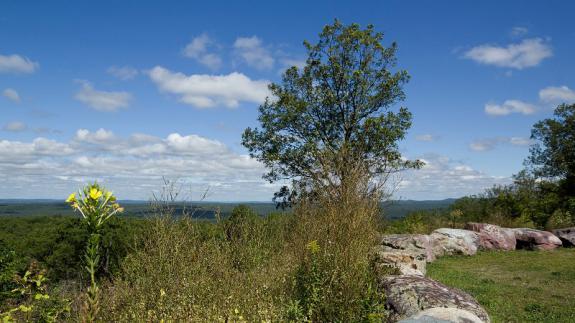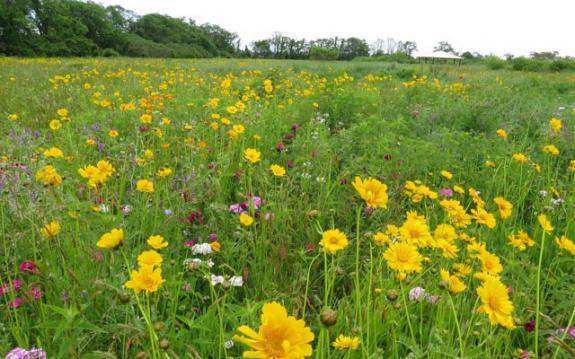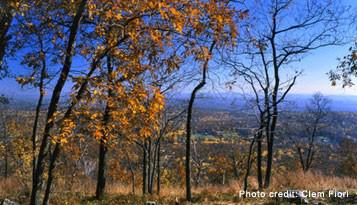Preserving Open Spaces for Wildlife throughout New Jersey
The ability to preserve open space in New Jersey plays a crucial role in our ability to protect native wildlife species. This undisturbed land provides habitat, food and water that is vital to the survival of many New Jersey species, specifically those that are at-risk. The Preserved Open Space Saves Wildlife initiative allows Conserve Wildlife Foundation of New Jersey to educate New Jersey citizens on the importance of protecting these open spaces. We are proud to partner with Green Acres and NJ Keep it Green on this initiative.
 Kittatinny Ridge includes the highest point in New Jersey, at 1803 feet above sea level, at High Point State Park. An important corridor for migratory raptors, like peregrine falcons and coopers hawks, and mammals, like the bobcat. Dave Blinder
Kittatinny Ridge includes the highest point in New Jersey, at 1803 feet above sea level, at High Point State Park. An important corridor for migratory raptors, like peregrine falcons and coopers hawks, and mammals, like the bobcat. Dave Blinder
Green Acres, a program within New Jersey’s Department of Environmental Protection, was created in 1961 to meet New Jersey’s growing recreation and conservation needs. Since its creation, more than 650,000 acres of open space has been protected and over $3.3 billion has been authorized to help fund Green Acres and its mission to preserve New Jersey’s land.
NJ Keep It Green represents more than 185 statewide, local and regional organizations committed to working together to sustain funding for the preservation and stewardship of New Jersey's waterways, wildlife habitat, natural areas, farmland, forests, parks and historic sites.
The critical link between preserving open space and protecting wildlife is often overlooked. While many people recognize the economic, recreational, and agricultural value of open space, they may not realize that the habitat protected sustains many of the state’s most treasured wildlife species. Preserved open space provides the sources of food, water, and shelter that many animals rely on to survive. If these natural lands were to be developed, habitats may become fragmented, making it difficult for animals to move through the landscape to find the resources they need.
The preservation and stewardship of open space sustains diverse wildlife populations in a great variety of habitats throughout the state by safeguarding vulnerable species against a myriad of threats, including steady urbanization, a dense network of roads, and a changing climate, making it increasingly important to protect land.
New Jersey is a leader in preserving open space for conservation. With the help of the Green Acres program, NJ Keep It Green, and public and nonprofit partners, we can work towards conserving the wildlife of New Jersey.
We would like to personally thank D&R Greenway Land Trust, The Nature Conservancy of New Jersey, New Jersey Audubon, New Jersey Conservation Foundation, and The Trust for Public Land for their commitment to preserving open spaces in New Jersey as members of NJ Keep It Green.
Featured Projects:
Abbott Marshlands

Photo by: Friends for the Abbott Marshlands
D&R Greenway Land Trust, along with Friends for the Abbott Marshlands and public entities who are property owners of the Marshlands, worked together to have Abbott Marshlands be declared as an open space in 2010.
The Abbott Marshlands is an oasis surrounded by urban development. The area is covered in lush marsh and swampland, tidal streams, ponds, beaver dams, tree-dotted islands, and wooded uplands. The Marshlands act as an important habitat for over 200 resident and seasonal bird species in addition to dozens of mammals, amphibians and reptiles.
Garrett Family Preserve at Cape Island Creek

Photo by: Dam Noe, The Nature Conservancy
The Nature Conservancy acquired the 180-acre Cape Island Creek in 2000 and was able to establish the Garrett Family Preserve at the site in 2013.
The preserve is a haven for migrating songbirds, raptors, and pollinators like bumblebees and monarch butterflies due to its native wildflower meadows, successional fields and tall tree lines. Many shorebirds, fish species and fiddler crabs thrive in the saltwater tidal marsh.
Salem River Wildlife Management Area

Photo by: Jean Lynch, New Jersey Audubon
Since 2009, New Jersey Audubon has planned and implemented habitat enhancement projects throughout Salem River Wildlife Management Area. New Jersey Audubon partners to care for this preserve with the New Jersey Division of Fish and Wildlife, the William Penn Foundation, the U.S. Fish and Wildlife Service, the Corporate Wetlands Restoration Program, the DuPont Clear into the Future Program, the Wildlife Management Institute, the U.S. Department of Agriculture, and local farmers.
The Salem River Wildlife Management Area provides habitat for priority wildlife species. Forested areas in the Salem Wildlife Management Area provide important breeding, stopover, and wintering habitat for songbirds and raptors and can provide young forest habitat for other species with specific habitat management needs, such as the American woodcock.
Kittatinny Ridge

Photo by: Clem Piori, New Jersey Conservation Foundation
New Jersey Conservation Foundation helped preserve the 850-acre property of Kittatinny Ridge.
The largely undeveloped mountains, forest, meadows and wetlands range from New York’s Shawangunk Mountains to the Delaware River. Kittatinny’s forested ridges provide critical habitat for wildlife. The area is an important migratory corridor for bald eagles, peregrine falcons, bobcat, hummingbirds, osprey, wood ducks, kingfishers and all owls, hawks and swallows.
Good Luck Point
 Old telephones that remain from an old trans-Atlantic communication array were home to ospreys. This year the poles were removed by USFWS and we installed new osprey nest platforms on some poles that were cut and left. Ben Wurst
Old telephones that remain from an old trans-Atlantic communication array were home to ospreys. This year the poles were removed by USFWS and we installed new osprey nest platforms on some poles that were cut and left. Ben Wurst
365 acres of Good Luck Point was purchased and preserved by The Trust for Public Land in 1999. They then purchased an additional 211 acres in 2003.
Good Luck Point’s tidal salt marsh is an important habitat area for bird migration and wintering spot along the Atlantic Flyway. It also acts as a nesting habitat for coastal songbirds, such as Salt Marsh and Seaside Sparrows, and feeding grounds for many species of ducks, geese, herons and egrets.






